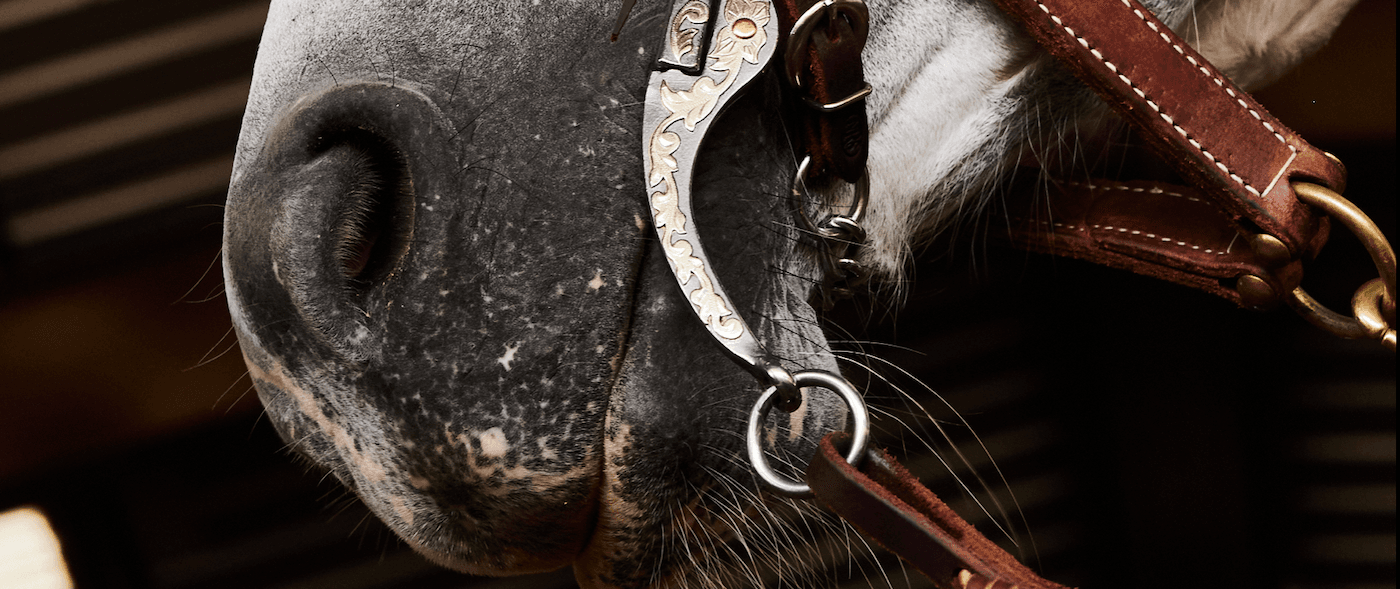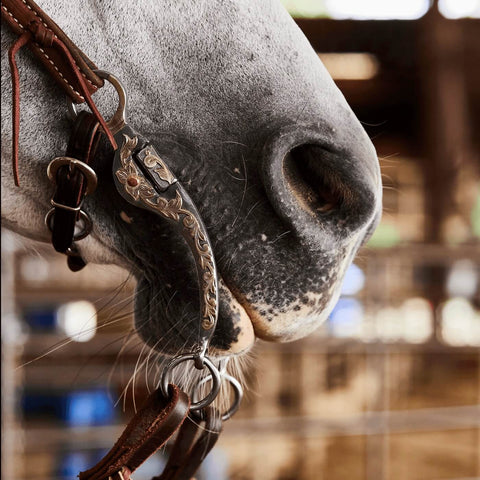
Horse Bit Types and Bit Fitting
The bit is an important piece of equipment when it comes to riding because it is one of the primary means by which a rider communicates with their horse. It is used to transmit signals and cues from the rider's hands to the horse's mouth, which in turn affects the horse's movement and behavior. A rider should always strive to use the lightest possible touch with the reins and the bit, and to provide clear and consistent cues to their horse. Using the wrong type of bit or using it incorrectly can cause discomfort or even pain for the horse, which can lead to resistance, disobedience, or even injury. Therefore, it's important to choose the right bit for your horse's needs and level of training, as well as your riding style and discipline. Proper fit, adjustment, and use of the bit are essential for your horse's comfort and safety.
Q : What Type of Bit does my Horse Need?
There are several types of horse bits available, each designed for a specific purpose and level of riding. Here are some of the most common Western and English bits :
SNAFFLE : The snaffle bit is the most basic and commonly used type of bit. It has a simple design, with a single joint in the middle and two rings on either end for the reins. The snaffle bit applies direct pressure to the horse's mouth and is suitable for most types of riding.
Professionals Choice Pro Smooth D-Ring Snaffle Bit
CORRECTION : A correction bit is a type of horse bit that is designed to provide more leverage and control over a horse's head and neck. It is typically used for Western riding disciplines, such as reining or barrel racing, where a high degree of control and precision is required.
Professionals Choice Professional's 7 Shank Slow Twist Correction Bit
GAG : The gag bit has a sliding cheekpiece that creates a gag action and applies pressure to the horse's poll and mouth. It is commonly used in eventing and jumping.
NRS Sliding Gag Snaffle Bit
COMBINATION : A combination bit combines elements of two or more types of bits, such as a snaffle bit and a curb bit or a hackamore and a snaffle bit.
Reinsman Martha Josey Million Dollar Rope Nose Combination Gag Bit
PELHAM : The Pelham bit has a shank (a straight or curved lever arm) that provides additional leverage and applies pressure to the horse's poll and chin. It has two sets of reins and can be used for both English and Western riding.
Partrade Trading Corporation Double Jointed Pelham
KIMBERWICKE : The Kimberwicke bit has a fixed cheekpiece that provides some leverage and applies pressure to the horse's poll, chin, and mouth. It is commonly used in English riding.
Partrade Trading Corporation Slotted Kimberwick
It's important to choose the right type of bit for your horse's needs and level of riding, and to ensure that it fits properly and is adjusted correctly. A professional trainer or equine specialist can help you select the right type of bit for your horse and teach you how to use it effectively.
Q : How do I fit My Horse for their Bit?
Properly fitting a bit for your horse is crucial to their comfort and communication with you while riding. Here are some general steps to follow:
- Start with a clean and dry bit. This will make it easier to see any signs of wear or damage.
- Ensure the correct size of the bit. A bit that is too small or too large can cause discomfort or even injury to your horse. The bit should fit comfortably in the horse's mouth with about 1/4 to 1/2 inch of space on either side.
- Adjust the headstall and reins. The headstall and reins should be adjusted so that the bit sits correctly in your horse's mouth. The headstall should fit snugly, but not too tight, and the reins should be long enough to allow for proper communication.
- Observe your horse's reaction. Once the bit is in place, watch your horse's behavior to make sure they are comfortable and able to respond to your cues. If your horse is showing signs of discomfort, such as head tossing, excessive mouth movement, or resistance to the bit, you may need to adjust the fit or try a different type of bit.
Remember, proper fitting of a bit is essential for your horse's comfort and safety, so take your time and make adjustments as needed. If you are unsure about how to fit a bit or which type of bit is best for your horse, consider consulting with a professional trainer or equine specialist.
Q : What Bit Piece Should my Horse Use?
There are many different types of bit pieces, each with their own unique design and function. Here are some common types :
The mouthpiece is the central part of the bit that goes into the horse's mouth. It can come in different materials, such as rubber, plastic, metal, or a combination of materials. The shape and size of the mouthpiece can also vary, with options such as a straight bar, jointed, ported, or twisted.
JOINTED - A jointed mouthpiece has a hinge in the center, allowing the bit to bend and move more easily. This can help reduce pressure points and provide a more comfortable fit for some horses.
Happy Mouth Jointed Loose Ring Bit
PORTED - A ported mouthpiece has a raised area in the center that provides extra space for the horse's tongue. This can be a good choice for horses with a low palate or a sensitive mouth.
Blessing Bits New Smooth Medium Port 8 Inch Bit
MULLEN - A mullen mouthpiece is a straight bar without any joints or ports. This can provide a more direct signal to the horse and is often used for horses with a lot of training or experience.
Professionals Choice Professional's Brittany Pozzi Medium Lifter Mullen Mouth Bit
ROLLER - A roller mouthpiece has a small roller in the center that can help keep the horse's mouth active and prevent them from getting bored or restless.
Blessing Bits New Dogbone with Copper Roller 8 Inch Bit
DOG BONE - The dog bone mouthpiece is designed to distribute pressure more evenly across the horse's tongue and bars, and can be a good choice for horses with a sensitive mouth or those that are resistant to other types of bits.
Reinsman Twisted Sweet and Sour Dog Bone Loose Ring Snaffle Bit
Q : How do English Bits differ from Western Bits ?
English bits and Western bits differ in their design and purpose, reflecting the different riding styles and traditions of each discipline!
Cheekpiece Design - English bits typically have a smaller and simpler cheekpiece design than Western bits, which often have long shanks or decorative silver designs. English bits often have a simple D-ring or eggbutt design, while Western bits may have a curb chain and a longer shank or more intricate cheekpiece design.
Rein Attachment - English bits usually have smaller rings or attachment points for the reins, while Western bits often have larger rings or slobber chains. The reins may be attached directly to the bit in English riding, while Western riding typically uses split reins that attach to the bit and the horse's saddle.
Pressure Application - English bits typically apply direct pressure to the horse's mouth, while Western bits often apply leverage and pressure to the horse's poll, chin, and mouth.


Q : What Types of Shanks can be on Bits ?
Bits can have various types of shanks, depending on their design and purpose, the most common :
Straight Shank - This is a simple, straight bar that connects the mouthpiece to the rein rings. Straight shanks are commonly used on snaffle bits or as the lower shank on leverage bits.
Curved Shank - This type of shank is curved, creating a slight bow shape. Curved shanks are designed to give the horse a more direct signal from the reins and often found on western-style bits.
Swivel Shank - This shank is designed to rotate freely, allowing the horse to move its head more naturally.
Purchase Shank -This is the top section of the shank, located above the mouthpiece. It connects the bit to the headstall and applies pressure to the poll when the reins are engaged.
Curb Shank -This is the lower section of the shank, located below the mouthpiece. It applies leverage and pressure to the horse's chin and poll when the reins are engaged.
Q : What is the Difference Between a D-Ring and a O-Ring Bit?
The main difference between a D-ring bit and an O-ring bit is their cheekpiece design. The D-ring bit has a D-shaped cheekpiece, while the O-ring bit has a circular or oval-shaped cheekpiece.
The D-ring bit is generally considered to be more stable than the O-ring bit. This is because the D-ring cheekpiece helps to prevent the bit from sliding too far through the horse's mouth or getting pulled through the mouth entirely. The D-ring also tends to distribute pressure more evenly on the horse's mouth, while the O-ring bit can create a more direct pressure point on one side of the mouth.
The O-ring bit is often used as a turning aid in English riding, as the shape of the cheekpiece allows for more lateral movement of the bit in the horse's mouth. This can make it easier for the rider to communicate directional changes to the horse. The O-ring bit has a looser rein attachment than the D-ring bit, which can make it a better choice for horses with sensitive mouths. However, the loose attachment can also create more play in the bit, which can be distracting for some horses.
Overall, both D-ring and O-ring bits can be effective in certain situations, depending on the horse's needs and the rider's preferences. It's important to choose the right bit for your horse's mouth anatomy, level of training, and riding discipline.














